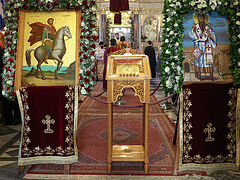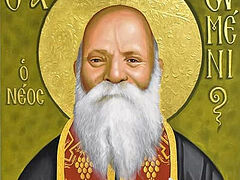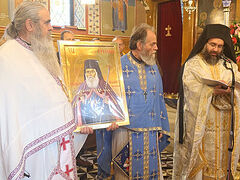Istanbul, June 15, 2022
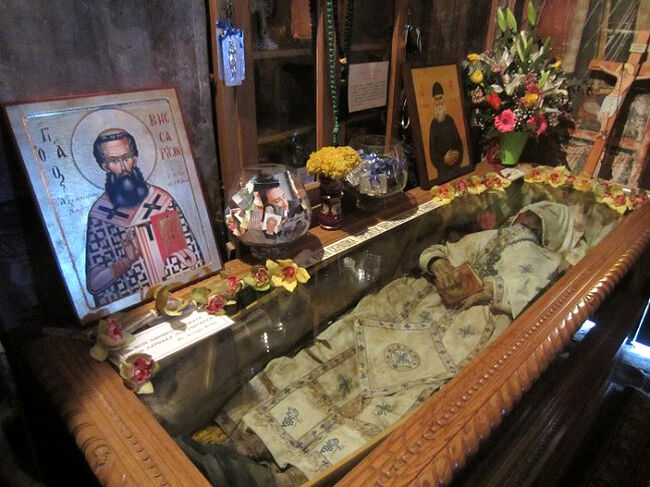 The incorrupt relics of St. Bessarion. Photo: orthodoxianewsagency.gr
The incorrupt relics of St. Bessarion. Photo: orthodoxianewsagency.gr
The Holy Synod of the Patriarchate of Constantinople added two new saints to the calendar of feasts at its session yesterday, June 14.
The New Hieromartyr Ananias (Lampardes), Metropolitan of Lacedaemon (+1764) was previously locally canonized by Metropolitan Eustathios of Sparta, who then submitted his name to Constantinople for universal recognition, reports Mystagogy.
“New of his official canonization was met with great joy in the Holy Metropolises of Monemvasia, Sparta, Gortynos, and Megalopolis.”
Constantinople also canonized Elder Bessarion of Agathonos, who reposed on January 22, 1991.
Materials for his canonization were submitted to the Synod of the Church of Greece in January 2019, and were then sent on to Constantinople.
“At this time, the semantra and the bells of our holy monasteries and holy churches are ringing joyfully throughout our Metropolis! But above all, the bells of all our hearts ring joyfully and tears of gratitude and praise run down our eyes,” Metropolitan Symeon of Fthiotida wrote in his announcement of the canonization.
***
Mystagogy provides a biography of St. Ananias:
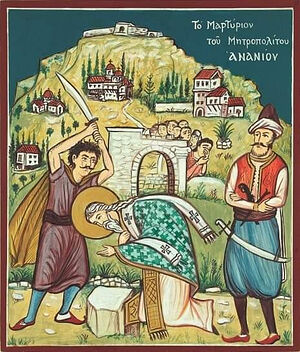 The martyrdom of St. Ananias. Photo: johnsanidopoulos.com The Holy Hieromartyr Ananias, known in the world as Anastasios, was born in the early eighteenth century to noble and affluent parents. His father, Theophiles, was a relative of the Lampardopoulos (Lampardes) family, and his mother was the daughter of Syntychos of Vyziki in Gortynia.
The martyrdom of St. Ananias. Photo: johnsanidopoulos.com The Holy Hieromartyr Ananias, known in the world as Anastasios, was born in the early eighteenth century to noble and affluent parents. His father, Theophiles, was a relative of the Lampardopoulos (Lampardes) family, and his mother was the daughter of Syntychos of Vyziki in Gortynia.
Ananias studied in the school of Dimitsana at Philosophou Monastery, where he probably became a monk and took the name of Ananias, and later in 1741 became the Bishop of Karyoupolis in Mani. In 1747 he was promoted to Metropolitan of Dimitsana and in February of 1750 he was made Metropolitan of Lacedaemon. In 1755 he wrote a special treatise on Sparta and his Metropolis.
He was distinguished for his education, high knowledge, his firm and unshakable ecclesiastical character, his goodness and his philanthropy. He was greatly revered by the Greeks, but terrified the Turks. This is why he became the president of all the leaders of the Morea. He supported the national element and defended the local armatoloi.
During the spring, summer and part of autumn, he stayed in Dimitsana, where he built an aqueduct, consolidated the annual taxes of the famous school of the Philosophou Monastery, and rebuilt in Mistra a magnificent Metropolitan Cathedral.
But the power of Metropolitan Ananias went beyond the Peloponnese, cause he had strong ties with the Patrairchates of Jerusalem and Alexandria, and the Ecumenical Throne of Constantinople was occupied with a native of Dimitsana, Patriarch Cyril V Karakalos, who was a lover of Russia and an enemy of the Latins. When Patriarch Cyril V was exiled, he came from Sinai to Dimitsana where he with Metropolitan Ananias began to proclaim the liberation of the nation and established schools.
In 1762 Metropolitan Ananias was sent to Constantinople to stand before the Grand Vizier and describe to him the misfortunes of the Peloponnese. He thus succeeded in preserving the Mora Valesi for the protection of Christians. At that time, at the initiative of the Saint, a large building was built for the school of Dimitsana, where the poor students gathered from all over the Peloponnese.
Wishing to weaken the Ottoman Empire and establish a pro-Russian independent Greek state, Russian emissaries of Catherine the Great had been sent to Mani in the mid-1760s to make a pact with the strongest local military leaders, and at the same time notable Greeks approached various Russian agents, discussing plans for the liberation of Greece. At the famous assembly, which was held in Kalamata, Ananias gave his blessing for the revolt.
Saint Ananias, after this, consulted with the captains and armatoloi of the Peloponnese and Mani, as well as with the presidents and chiefs of the provinces of the three islands of Hydra, Spetses and Psari, for the liberation of their homeland. With the care and expense of the Saint two mills were established in Dimitsana.
For these things Metropolitan Ananias was betrayed to the Mora Valesi, being accused of conspiring with the Russians against the Turks. Many sought armed resistance to help the Saint, but he suggested that he take the fall alone so the Turks would not think there was an organized movement. After partaking of Holy Communion, he gave himself over to the soldiers, who arrested him. Saint Ananias knelt, and with incredible willingness, he told the executioner to strike him. Blood bounced from his decapitated head and stained the west door of the Metropolitan Cathedral of Mistra. This took place on April 15, 1764.
The Turks dragged the sacred body of the Hieromartyr to the middle of the street where it was left for three days unburied. As soon as the Turks left, the Christians took the body and buried it with honor. Meanwhile, the decapitated head of the Saint was brought to the Vizier.
***
Archimandrite Bessarion was born in Petalidi, Messinia in 1908, receiving the name Andreas in Baptism.
At the age of 18 he went to Kalamata where he met with spiritual men and decided to enter the clergy. He was tonsured as a monk with the name Bessarion and later ordained as a deacon and then priest.
Fr. Bessarion received a deep theological training through his study of the Holy Scriptures and the other holy texts of the Church.
In 1935, he went to Karditsa at the invitation of His Eminence Metropolitan Ezekiel, where he dedicated himself to philanthropic activities. In 1955, he went to Atathonos Monastery in Fthiotida, where he took up the spiritual revival of the monastery.
Every Monday and Tuesday, he would go to the hospitals in Lamia to visit and console the sick and hear their confessions. With his charismatic personality and love for men, he succeeded in comforting weary souls.
Elder Bessarion fell asleep in the Lord in Athens on January 22, 1991. His relics were discovered to be incorrupt on March 3, 2006.
Follow OrthoChristian on Twitter, Vkontakte, Telegram, WhatsApp, MeWe, and Gab!

